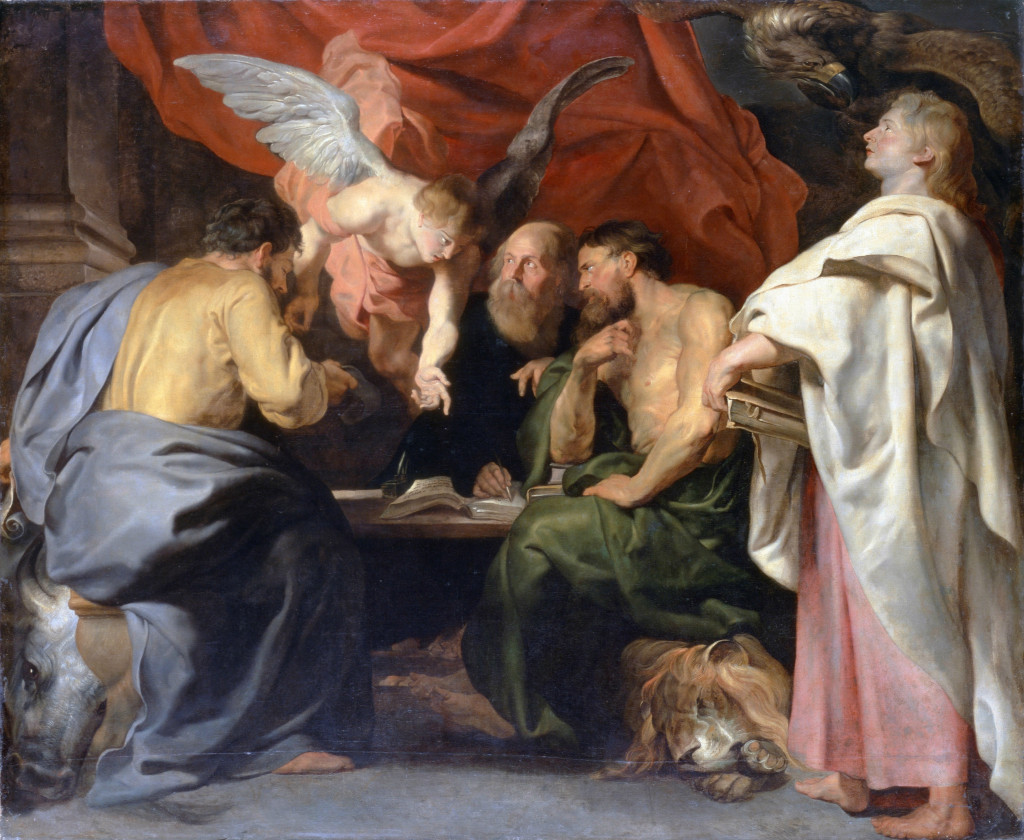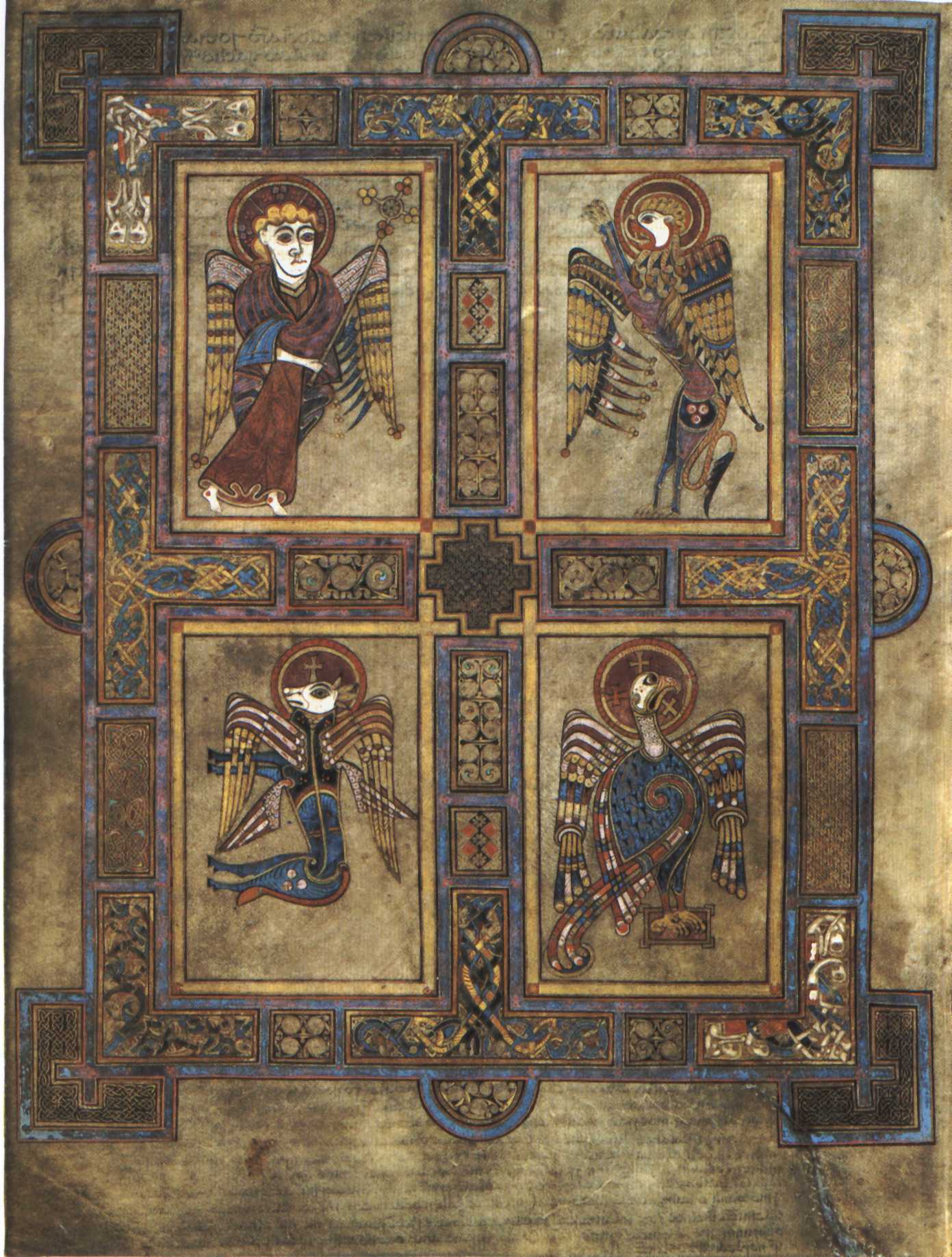There is an old saying which we only half understand these day; “neither rhyme nor reason.” Which means a thing is pure nonsense if it contains no discernible logic or poetry. We postmodern-moderns have little use for truth conveyed or encapsulate in poetry. If a thing is not ‘scientific’ we reject it. But this is to our own detriment especially when trying to understand things from the past. Perhaps it goes back to that grand instance of rejecting ethnocentric poetry for heliocentric logic. Poetry has lost ever since, though the church has only begun losing it recently. But to hear it told, they lost to Galileo and his telescope 500 years ago.

Die Vier Evangelisten, Peter Paul Rubens c. 1614 Can you identify each Evangelisty by his creature?
What is poetic order? It is not mere rhyming. It is combinations of things which are not logical, yet which can convey truth nonetheless. They might be elements from old stories combined with new stories, themes from one area of study applied to another, dividing things into a certain number of parts, combining things into a certain number of groups. The Hebrew mind like most premodern cultures, was very poetic. Their poetic devices included repeating things three times for emphasis, use of chiasm which is symmetrical pairs of lines or themes with the focus at the center, and the use of significant numbers. Such is the case with the four gospels. Both before the Church canonized four gospels and after, the number four had significant connections with other things. These connections were not logically connected but poetically.

Saint Irenaeus, 130-202AD
Irenaeus was an early Church father and theologian. He was a champion for the faith fighting the Gnostic heresy much of his life. He said of the four gospels:
It is not possible that the Gospels can be either more or fewer in number than they are. For, since there are four zones of the world in which we live, and four principal winds, while the Church is scattered throughout all the world, and the “pillar and ground”1 Timothy 3:15 of the Church is the Gospel and the spirit of life; it is fitting that she should have four pillars, breathing out immortality on every side, and vivifying men afresh. From which fact, it is evident that the Word, the Artificer of all, He that sits upon the cherubim, and contains all things, He who was manifested to men, has given us the Gospel under four aspects, but bound together by one Spirit. . . .”For the cherubim, too, were four-faced, and their faces were images of the dispensation of the Son of God. For, [as the Scripture] says, “The first living creature was like a lion,” Revelation 4:7 symbolizing His effectual working, His leadership, and royal power; the second [living creature] was like a calf, signifying [His] sacrificial and sacerdotal order; but “the third had, as it were, the face as of a man,”— an evident description of His advent as a human being; “the fourth was like a flying eagle,” pointing out the gift of theSpirit hovering with His wings over the Church. And therefore the Gospels are in accord with these things, among which Christ Jesus is seated.
. . .And the Word of God Himself used to converse with the ante-Mosaic patriarchs, in accordance with His divinity and glory; but for those under the law he instituted a sacerdotal and liturgical service. Afterwards, being made man for us, He sent the gift of the celestial Spirit over all the earth, protecting us with His wings. Such, then, as was the course followed by the Son of God, so was also the form of the living creatures; and such as was the form of the living creatures, so was also the character of the Gospel. For the living creatures are quadriform, and the Gospel is quadriform, as is also the course followed by the Lord. For this reason were four principal (καθολικαί) covenants given to the human race: one, prior to the deluge, under Adam; the second, that after the deluge, under Noah; the third, the giving of the law, under Moses; the fourth, that which renovates man, and sums up all things in itself by means of the Gospel, raising and bearing men upon its wings into the heavenly kingdom.
This led to the medieval organization. Matthew was associated with the face of man because he begins his gospel with a geneology of Christ. Mark was associated with the face of a lion because his gospel emphasizes the conquering king. Luke was associated with the ox because he begins his gospel with the priestly sacrifice of Zacharias. John because his gospel seems to soar beyond the others to gaze into the sun as it expounds the mysteries of the incarnation, a man. These themes were so common that often the icon would be used instead of the title. They were widely used in church architecture, the four beasts often surrounding the icon of Christ. Their stones cried out, while ours cry “pragmatism”. They became themes for the Christian walk. He was created a man, must sacrifice himself as the ox, must have the courage of the lion and would one day soar as the eagle to heaven.

The Four Evangelists, Book of Kells c. 800
More recently James B. Jordan has modified Irenaeus’ scheme a little bit and added comparisons to history:
| Author | Old Testament History | New Testament History | Face |
| Matthew | Mosaic/Priestly | Jacobin (James) | Ox |
| Mark | David/Kingly | Petrine | Lion |
| Luke | Exilic/Prophetic | Pauline | Eagle |
| John | Combination of all 3 | Johanine | Man |
I think this can be very helpful. Matthew is the most Jewish gospel containing the most Old Testament allusions so it get’s the ox which was associated with sacrifice. The eagle was the symbol of Rome or the Gentiles, John took his gospel farther into the strange new territory of the new creation ushered in by the incarnation. The shift from Peter to Paul is evident in in Acts. But before them James was apparently the leader of the church which is why he was the first of the twelve disciples to be executed Acts 12:2. Later John’s other writings wrap up the New Testament canon.
While reason and statistical analysis might give us one picture of Mark we would do better to study a poetic people poetically. So we begin our long study of the Lion. Though Jesus was a servant, Mark, in his gospel, is telling us about a conquering king. But, that will have to wait until later.
Further Reading: The Four, Peter J. Leithart
